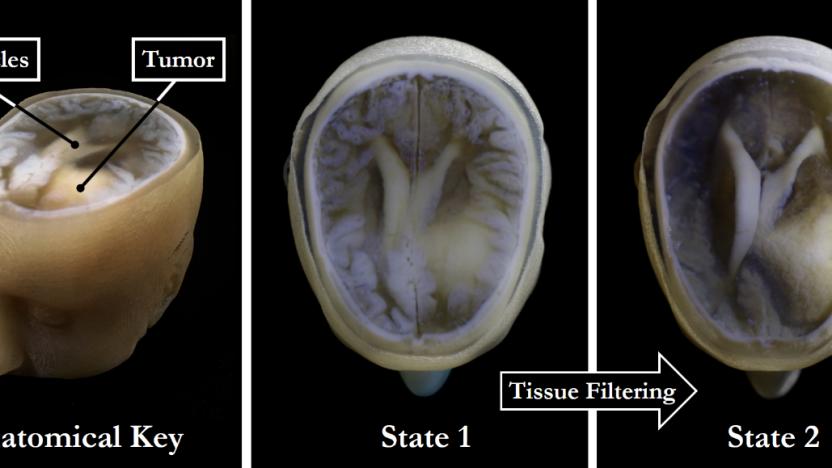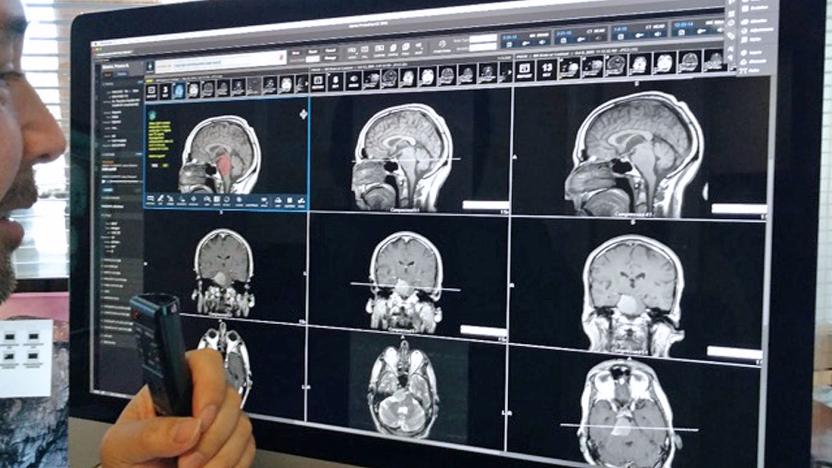medicalimaging
Latest

You'll soon be able to get a 3D printed model of your brain
There are almost limitless possibilities when it comes to 3D printing. Design your own color-changing jewelry? Fine. Fabricate your own drugs? No problem. Print an entire house in under 24 hours? Sure! Now, researchers have come up with a fast and easy way to print palm-sized models of individual human brains, presumably in a bid to advance scientific endeavours, but also because, well, that's pretty neat.

In IBM's future, Watson will be your doctor
IBM is working on a way to make its Watson supercomputer a far more effective medical tool for flesh-and-blood doctors. The company wants to use the platform to analyze medical imaging data to learn what a healthy set of insides looks like. It should then be able to identify when things have gone awry in scan images to direct doctors toward areas of concern. If this data is merged with each patient's medical records, it could mean faster and more effective treatment for serious conditions.

Sony sells a chunk of its Olympus stake for a fast buck
Kaz Hirai's plans to save Sony have run from integrating its many disparate business units through to just selling off everything, even the stuff that's nailed down. Now, the company is getting rid of half of its stake in Olympus in the hope of raising some extra cash for "growth investments." Sony took a $645 million stake in the one-time rival back in 2012 as an attempt to get in on Olympus' lucrative medical imaging business -- which was spun off into a joint venture. Sony may no longer be Olympus' biggest shareholder, but the pair will still collaborate on healthcare and imaging devices. Someone should tell Hirai that he'd better spend this money wisely -- he's running out of things to sell. [Image Credit: Koji Sasahara/Associated Press]

Sony makes Olympus rescue pact official with $645 million investment
After months of speculation about who would step in to save the scandal-ridden Olympus' rocky fortunes, Sony has finally opened up its checkbook. The two companies are entering into a "business and capital alliance," with Sony pumping in $650 million to its former rival. In exchange, it's gaining a seat on the company's board and a 51 percent stake in a new joint venture based on Olympus's coveted medical imaging tech -- something Kaz Hirai outlined in his "One Sony" strategy. The deal also includes a component-sharing agreement in the photography space, with Olympus mirror cells and camera lenses being given to Sony, while image sensors (where Sony is very strong) will go the other way.

Olympus hangs $57 million loss on austerity, strong yen and declining compact camera market
Olympus is reporting a $56.7 million loss for its first quarter of 2012. While its coveted medical imaging arm remains profitable, its life-science and industrial unit suffered thanks to corporate belt-tightening. Unsurprisingly, its low-end compact camera market is shrinking, but sales of its OM-D E-M5 ILC increased by 50 percent, offsetting some of the losses and reducing operating losses from $89 million last quarter to $19 million in this one. Like many of its Japanese rivals, it's also found a strong yen has stifled its return to productivity, a trend that isn't likely to change soon.

Olympus scales back, shifts focus to turn around fortunes
Beleaguered camera maker Olympus vows to shed around 2,700 jobs and heavily restructure its business following a major accounting scandal. That works out that around seven percent of its total global workforce will be cut, with Olympus also aiming to sell unused property and close its Philippines plant over the next two years. The Japanese manufacture will also refocus on profitable imaging, medical and life-science departments -- presumably fields that would-be suitor Panasonic's also interested in. Update: Or perhaps not.

Panasonic gearing up to offer $635 million bailout to save troubled Olympus (update)
Panasonic is reportedly putting the final touches to a 50 billion yen ($635 million) bailout package to save Olympus. Panasonic will become the largest shareholder of the scandal-ridden camera maker, reeling from a $1.7 billion accounting fraud uncovered last year, with an eye on getting a foothold in Olympus' profitable medical imaging business. It gives us hope that the current range of blockbuster shooters including the OM-D won't be sacrificed in a last-ditch attempt to make the books balance. Update: Outgoing Panasonic president Fumio Ohtsubo has strongly denied the reports, saying that there's no company plan to invest. That clears that up, then.

Scientists produce laser light from human kidney cells, we get in touch with our inner Cyclops
Scientists have just created living laser light out of a human cell and some jellyfish protein, but it's not quite as terrifying as it sounds. Developed by Malte Gather and Seok Hyun Yun at Massachusetts General Hospital, the new technique revolves around something known as green fluorescent protein (GFP) -- a naturally glowing molecule found in jellyfish that can be used to illuminate living material. After genetically engineering a human kidney cell to express this protein, Gather and Yun wedged it between two mirrors in an inch-long cylinder, filled with a GFP solution. Then, they infused the system with blue light, until the cell began to emit its own pulses of bright green laser light. Researchers also noticed that the cell could regenerate any destroyed fluorescent proteins, potentially paving the way for scientists to conduct light-based therapy and medical imaging without an external laser source. Hit the source link for more information, though you'll need a subscription to Nature Photonics to access the full article.

World's biggest CMOS sensor could help doctors detect and treat cancer
Move over, Canon, because scientists at the University of Lincoln have just seized the crown for world's biggest CMOS image sensor with their new Dynamic range Adjustable for Medical Imaging Technology microchip -- or 'DyNAMITe,' for short. Measuring a hefty 12.8 square cm (or about five square inches), DyNAMITe is roughly 200 times bigger than the chips you'd find in most PCs, making it the largest imager ever made on a wafer of standard, eight-inch diameter. This extra girth allows the active pixel sensor to capture images in high detail, with a 100-micrometer pitch boasting 1280 x 1280p aligned next to a 50-micron layer, carrying 2560 x 2560p. DyNAMITe can also run at up to 90fps and withstand high levels of radiation for several years, making it ideal for medical imaging, including radiotherapy and mammography. Researchers say these enhanced images could help doctors detect cancer in its earliest phases, while allowing them to monitor radiotherapy treatments more closely. No word on when we should expect to see DyNAMITe pop up in hospitals (or a Hasselblad back), but physicists at the Institute of Cancer Research and Royal Marsden Hospital are busy looking for other, potentially life-saving applications. Full PR after the break.

OmniVision releases OV6930, the 1.8mm square camera sensor, coming to an incision near you
Usually we like writing about bigger camera sensors -- bigger meaning more light, better quality, and more machismo. But, when you're dealing with a camera that could very well find itself inserted inside your body, we're just fine with smaller, thanks and, at 1.8 x 1.8mm, OmniVision's new OV6930 is about as small as it gets. No, you won't be getting 1080p from that like you would from the company's (relatively) monstrous 3.5mm beast for cellphones, you'll have to deal with just 400 x 400. No word on whether this model will wind up in a pill like an earlier version from 2006, but give it a nice sugar coating and we'd take one -- for science.




